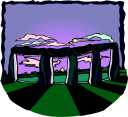Stonehenge Still a Mystery
Stonehenge.
Why was it built? Does anyone really know?
Various
theories have been put forth through the years. Some people
have thought that the stones were part of religious rites
practiced by sun worshippers.  One
scientist has even proved that the northeast axis of the
stones aligns with the sunrise at the summer solstice. Other
theories have the stones being part of a complicated system
of astronomical observation. What is for sure is that no one
knows for sure why Stonehenge was built.
One
scientist has even proved that the northeast axis of the
stones aligns with the sunrise at the summer solstice. Other
theories have the stones being part of a complicated system
of astronomical observation. What is for sure is that no one
knows for sure why Stonehenge was built.
It
is not the only set of megaliths in Britain, by any means.
But it is the most famous.
The
stones that remain are Stonehenge III, built in the third
and second centuries B.C. The first Stonehenge was a product
of the British Neolithic culture, about 3100 B.C. These
people created a 320-foot-diameter ditch and then used the
dirt they dug up to create a high mound within the circular
ditch. Just inside the ditch were dug 56 shallow holes.
These were soon refilled. The purpose of both actions is
unknown. Stonehenge I did include entry stones, though, and
this links it to successive stone patterns.
For
500 years, the Neolithic people used Stonehenge for an
unknown purpose; then, it was abandoned. It took another 500
years for Stonehenge to return.
Beginning
about 2100 B.C. the people of ancient Britain built on the
past by adding 80 bluestone pillars, each of which weighed
up to 4 tons. The intent was to form two concentric circles;
neither was completed. Two facts about Stonehenge II stand
out: The stones were very heavy to begin with, and they came
from the Preseli Mountains in southwestern Wales, 240 miles
away.
 What
we today can see of Stonehenge was built beginning about
2000 B.C. To the circles of bluestones the builders added
sarsen stones from Marlborough Downs, 20 miles away. These
stones are up to 30 feet in length and 50 tons in weight. It
is significant that these stones--some of which were
undoubtedly rough and craggy--were made shiny smooth and, in
some cases, curved. Also in the construction of Stonehenge
III was the digging of holes for yet another circle of
stones; this work was not completed.
What
we today can see of Stonehenge was built beginning about
2000 B.C. To the circles of bluestones the builders added
sarsen stones from Marlborough Downs, 20 miles away. These
stones are up to 30 feet in length and 50 tons in weight. It
is significant that these stones--some of which were
undoubtedly rough and craggy--were made shiny smooth and, in
some cases, curved. Also in the construction of Stonehenge
III was the digging of holes for yet another circle of
stones; this work was not completed.
These
are known facts. What is not known for sure is how the
stones were carried to the Salisbury plain. Some have
speculated, even claimed to prove, that the transport was
done via waterways. The technology to do this must have been
advanced indeed. And if land-based transportation was the
answer, then the efforts required must have been on par with
those required to build a small Egyptian pyramid.
What
has yet to be proved is why Stonehenge was built and how it
was used. The passage of time has obscured all but the most
obvious of clues, and these do not seem to be enough.